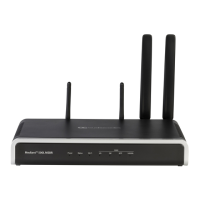User's Manual 67. Configuration Parameters Reference
Version 6.8 909 Mediant 500L MSBR
Parameter Description
some ISDN variants), the Connected Party number and name
from Q.931 Connect message to SIP 200 OK with the P-
Asserted-Identity header. In the opposite direction, if the ISDN
device receives a 200 OK with P-Asserted-Identity header, it
interworks it to the Connected party number and name in the
Q.931 Connect message, including its privacy.
Web/EMS: Use Destination As
Connected Number
[UseDestinationAsConnectedNu
mber]
Enables the device to include the Called Party Number, from
outgoing Tel calls (after number manipulation), in the SIP P-
Asserted-Identity header. The device includes the SIP P-
Asserted-Identity header in 180 Ringing and 200 OK responses
for IP-to-Tel calls.
[0] Disable (default)
[1] Enable
Notes:
For this feature to function, you also need to enable the
device to include the P-Asserted-Identity header in 180/200
OK responses, by setting the AssertedIDMode parameter to
Add P-Asserted-Identity.
If the received Q.931 Connect message contains a
Connected Party Number, this number is used in the P-
Asserted-Identity header in 200 OK response.
This parameter is applicable to ISDN, CAS, and/or FXO
interfaces.
Web: Caller ID Transport Type
EMS: Transport Type
CLI: caller-ID-transport-type
[CallerIDTransportType]
Determines the device's behavior for Caller ID detection.
[0] Disable = The caller ID signal is not detected - DTMF
digits remain in the voice stream.
[1] Relay = (Currently not applicable.)
[3] Mute = (Default) The caller ID signal is detected from the
Tel side and then erased from the voice stream.
Note: Caller ID detection is applicable only to FXO interfaces.

